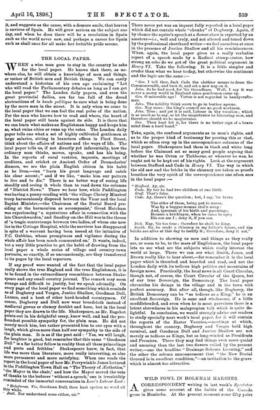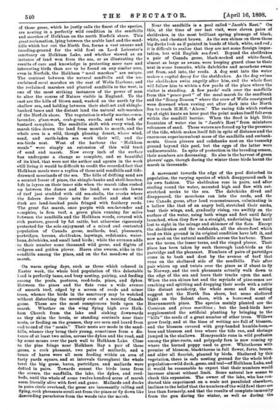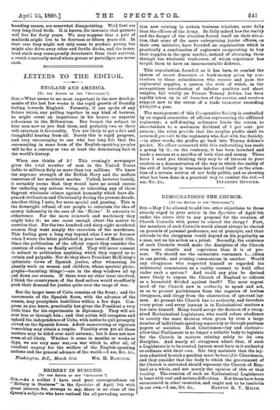WILD FOWL IN HOLKHAM MARSHES.
ACORRESPONDENT writing in last week's Spectator gives some account of the habits of the Canada geese in Manitoba. At the present moment some fifty pairs
of these geese, which he justly calls the finest of the species, are nesting in a perfectly wild condition in the sandbills and marshes of Holkham on the north Norfolk shore. This great reclamation, lying between the arable land and the sand- hills which bar out the North Sea, forms a vast annexe and breeding-ground for the wild fowl on Lord Leicester's sanctuary on Holkham Lake, and whether viewed as an instance of land won from the sea, or as illustrating the results of care and knowledge in protecting more rare and interesting birds than are to be found on any similar area, even in Norfolk, the Holkham " meal marshes" are unique. The contrast between the natural sandhills and the un- reclaimed meal marshes on the east of Wells Harbour, and the reclaimed marshes and planted sandbills to the west, is one of the most striking instances of the power of man to alter the course of Nature visible in England. To the east are the hills of blown sand, washed on the north by the shallow sea, and holding between their shell-set and shingle- banked bases and the distant land the natural salt-marshes of the Norfolk shore. The vegetation is wholly marine,—sea- lavender, glass-wort, crab-grass, suceda, and vast beds of bastard samphire. The sandbills shift with every wind, the marsh tides drown the land from month to month, and the whole area is a wild, though pleasing desert, where wind, sand, and earth-laden sea work their will, and the sea-birds nest. West of the harbour the Holkham meals" were simply an extension of this wild tract of sand and marsh. Now every inch of the surface has undergone a change so complete, and so beautiful of its kind, that were not the author and agents in the work Atill living it would be difficult to credit the recorded fact that Holkham meals were a replica of these arid sandhills and tide- drowned moorlands of the sea. The hills of drifting sand are a scented forest of pines, the shingle-banks and shell-beaches, left in layers on their inner side when the marsh tides rushed up between the dunes and the land, are smooth lawns of turf jest studded with old sea-shells, the creeks where the fishers drew their nets for mullet and shot wild duck are land-loocked pools fringed with feathery reeds. The great flat marsh, once purple with sea-lavender and samphire, is firm turf, a green plain running for miles between the sandhills and the Holkham woods, covered with rich pasture, grazed by fat cattle, but otherwise rigorously protected for the sole enjoyment of a mixed and contented population of Canada geese, mallards, teal, pheasants, partridges, herons, sheldrakes, lapwings, redshanks, water- ' hens, dabchicks, and small land birds ; while the autumn adds to their number some thousand wild geese, and flights of widgeon and golden plover. Hares also swarm, alike in the sandhills among the pines, and on the flat meadows of the marsh.
On warm spring days, such as those which ushered in Easter week, the whole bird population of this delectable land is perfectly tame, and busy nesting, pairing, and feeding among the pools, pastures, reed-beds, pines, and dykes. Between the pines and the flats runs a wide avenue of smooth turf, edged by a screen of reeds and minor trees, whence the birds in the sanctuary may be watched without disturbing the serenity even of a nesting Canada goose. These are the most conspicuous birds upon the marsh. Whether on the wing flying high over Holk- ham Church from the lake and sinking downwards as they skim the levels, or standing sentinels near their nests, or feeding on the grasses, they are seen and heard from cud to end of the " meals." Their nests are made in the sand- hills, whence they bring their young, sometimes from a dis- tance of at least two miles, across the dykes and the road, and by some means over the park wall to Holkham Lake. Close to the pine fringe near Holkham Bay a pair of these geese, a cock pheasant, two pairs of mallards, and a brace of hares were all seen feeding within an area of forty yards square, and at intervals throughout the whole level the big geese, hares, partridges, and mallards were dotted in pairs. Towards sunset the birds issue from the covers, the sandhills, the lake, the dykes, and reed- beds, until the whole of some twelve hundred acres of marsh seem literally alive with fowl and game Mallard's and ducks in pairs circle overhead, the geese are incessantly calling and flying, cock pheasants stroll out from the pines or fly down like aleacending parachutes from the woods into the marsh. Near the sandhills is a pool called "Jacob's Rest." On this, at the time of our last visit, were eleven pairs of sheldrakes, in the most brilliant spring plumage of black, white, and chestnut brown. As the sun shines on them these big ducks look as if painted in bands of black, white, and red ; it is difficult to realise that they are not some foreign impor- tation, but wild English sea-fowl. Beyond the sheldrakes a pair of Canada geese, black-necked and white-faced, almost as large as swans, were keeping guard close to their neat in some tussocks, while dabchicks and moorhens swam out from, and into, the reeds. A dog sent into the water , makes a capital decoy for the sheldrakes. As the dog swims the sheldrakes swim angrily after him, and the whole fleet will follow him to within a few yards of the place where the visitor is standing. A few yards' walk over the sandhills from this " peace-pool " of the meal-marsh lie the sandbank and the " Scaup Beacon " where the crew of Wells coastguard were drowned when rowing out after dark into the North Sea to reach H.M.S. ' Alarm.' The racing tide which rushes up at eight knots an hour past the point makes itself felt even within the sandhill barrier. When the flood is high little fountains of water rise in " Jacob's Rest" from miniature volcanoes of sand. These waters are forced up by the pressure of the tide, which makes itself felt in spite of distance and the enormous superincumbent mass of the sandhills and embank- ments. Green plovers and redshanks nest on the tussocky ground beyond this pool, but the eggs of the latter were undiscoverable. In spite of protection in the breeding season, their numbers are decreasing. So also is the harvest of green plovers' eggs, though during the winter these birds haunt the marsh in thousands.
A movement towards the edge of the pool disturbed its population, the varying species of which disappeared each in its own fashion. The sheldrakes rose in pairs, and after circling round the water, mounted high and flew with out- stretched necks to the sea. The dabchicks dived and disappeared, the moorhens ran into the reeds, and the two Canada geese, after loud remonstrances, culminating in a bellow like that of an angry bull, stretched their necks, beat their wings, and, gradually rising, ran swiftly on the surface of the water, using both wings and feet until fairly launched, when they flew in a straight, undeviating line until lost to sight in the mirage and shimmer of the flats. Except the sheldrakes and the redshanks, all the shore-fowl which bred on this ground in its original condition have left it, and now nest on the natural sandhills across the harbour. These are the terns, the lesser terns, and the ringed plover. Their place has been taken by such thorough land-birds as the partridge and the pheasant. Numbers of pairs of partridges come in to bask and dust by the avenue of turf that runs on the sheltered side of the sandhills. Pair after pair whirrs up and twists over the pines as if about to fly to Norway, and the cock pheasants actually walk down to the edge of the sea and leave their tracks upon the sand. When the sun shines hot and the myriads of pine-cones are cracking and splitting and dropping their seeds with a rattle like distant musketry, the whole scene and its setting suggest not the North Sea shore, but some sheltered bight on the Solent shore, with a borrowed scent of Bournemouth pines. The species mainly planted are the Corsican and pinta maritima ; but the land-birds have supplemented the artificial planting by bringing to the " hills " the seeds of a great number of other trees. Willows grow freely, and at the time of writing are full of blossom, and the blossom covered with grey-banded humble-bees,- bees and blossom and tree where the tide ran, and shrimps jumped in the shallows. Honeysuckle runs in wild profusion among the pine-roots, and polypody fern is now coming up where the horned poppy used to grow. Whitethorns with promise of blossom, blackthorns in full flower, furze, broom, and alder all flourish, planted by birds. Sheltered by this vegetation, there is safe nesting ground for the whole bird- population—wild duck, geese, and teal—of Holkham Lake, and it would be reasonable to expect that their numbers would increase almost without limit. Some natural law seems to check this expansion. The owner of the lake, who has con- ducted this experiment on a scale not paralleled elsewhere, inclines to the belief that the numbers of the wild fowl there are less than formerly, and that the results of complete immunity from the gun daring the winter, as well as daring the breeding season, are somewhat disappointing. Wild fowl are very long-lived birds. It is known, for instance, that gannets will live for forty years. We may suppose that a pair of mallards .might live to be fourteen or fifteen years old. In that case they might not only cease to produce young, but might also drive away other and fertile ducks, and the home- bred stock may consequently deteriorate from their survival, a result constantly noted where grouse or partridges are never shot.




































 Previous page
Previous page